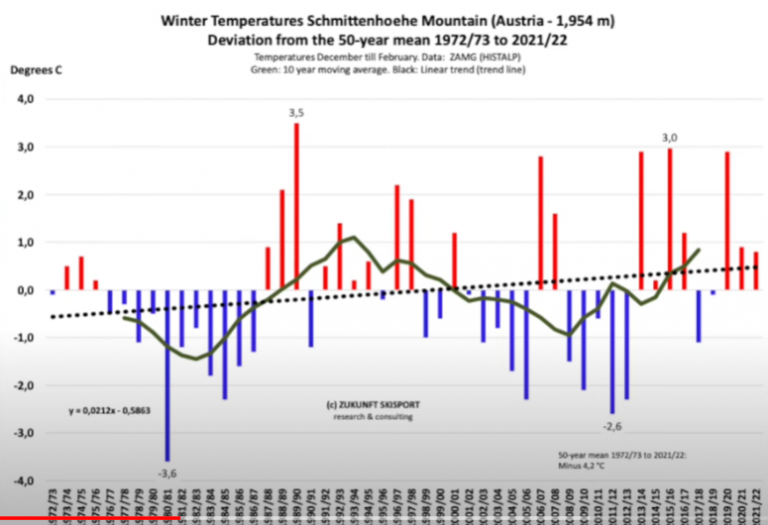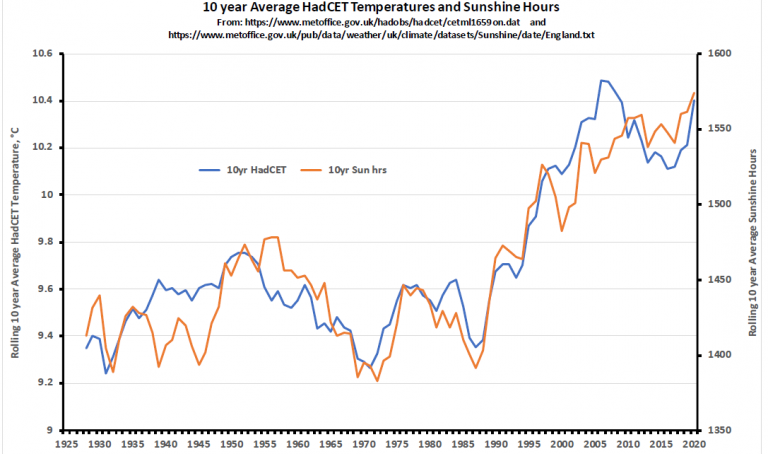Austrian ski industry researcher Günther Aigner looks at the winter temperatures over the past 50 years at the famous Schmittenhöhe ski resort in the Austrian Alps, some 1,954 meters above sea level.
In the video, Aigner looks at how much winters have warmed over the period in question and whether it has had any significant impact on skiing. Global warming alarmists have warned that skiing would be dramatically curtailed as snowy winters disappear due to warming.
Aigner shows the winter mean temperature data, whose linear trend shows there’s been an increase of 1.0°C over the past 50 years. A trend Aigner describes as “not statistically significant” and well within the range of natural variability:
Cropped here.
Note that the upward trend is primarily due to the very cold period in the late 1970s and early 1980s. Overall there’s been little linear change over the past 35 years.
Interestingly, the warmest 3-year period occurred in the winters of 1988 – 1990. Four of the top six coldest winters in fact happened in the last 16 years.
The 1.0°C of linear trend warming presented by Aigner means the snowline has moved uphill 150 meters, thus not greatly affecting ski conditions.
What has warmed, Aigner says, are the summers at the ski resort. Here summer temperatures have increased by 3.2°C. That warming probably has more to do with greater number of sunshine hours, and less to do with manmade CO2. For example, Central England temperature has followed along with the number of sunshine hours, and not CO2.
Chart: Met Office UK
So far there has been no hard evidence offered to show that CO2 leads to more sunshine.
In summary, skiers need not worry about snow disappearing from the European Alps and can count on continued excellent conditions for years to come. Ignore the climate doomsayers.







Why 50 years?
Why not 150 years or his his time (and slide rule) limited?
So skiing is not a thing of the past.
Who could have guessed?
Meanwhile, in central Wash_State, my garden plants think spring has come.
I hope they are right.
[…] From the NoTricksZone […]
[…] From the NoTricksZone […]
[…] From NoTricksZone […]
[…] From the NoTricksZone […]
[…] From the NoTricksZone […]
[…] From the NoTricksZone […]
Sun and temperature are coupled. Nice graph!
It has to bee climate related and may bee of concern for some-I don’t know whom?
[…] Ski Industry Expert: Austrian Ski Resort Temperature Rise Over Past 50 Years “Not Statisticall… […]
In 2010 I wrote a piece in Tallblokes Talkshpp that looked at the relationship between Bright Sunshine and Maximim Daily Temperatures from 1930 to 2010 in Central England. It wasn’t an elegant paper but it showed Delta Max Temp rising and falling with Delta Bright Sunshine. My conclusion was that 90%+ of temperature rise and fall could be explained by changes in cloud cover and the AMO cycles.
What’s needed is the this study being done redone with the digital detail.
As in:
1. Plot Deltas of total sunshine hours vs Delta average daily temperatures
2. Plot Deltas of daily BRIGHT sunshine hours vs Delta daily maximum temperatures.
Bright sunshine and max temperatures are better than averages. We all know from experience a few minutes of no cloud heats for the moment a large amount, which controls the maximum. Average temperatures and generalized sunshine make the connection harder to recognize.
Now that we have global cloud cover data, direct or indirct CERES data rect, we could do this for the global case.
Cross plot Delta CET and Delta sunshine. The results show an up and down relationship that goes back and forward, a bow tie figure superimposed on a with a minor linear increase in time.
O
The slight linear increase is either CO2 or a long term trend of the AMO and PDO.
Just saying
I’d do it I don’t know where to find the data.
[…] Aigner of 12 mountains stations across the Alps from Switzerland and Germany to Austria. Now, again thanks to No Tricks Zone, we report that Aigner is at it again, with a study of one particular resort in Austria, […]